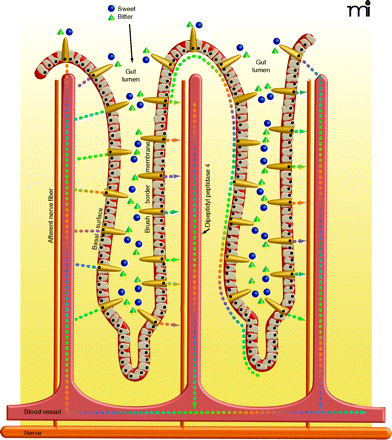
- Institution: Stanford Univ Med Ctr Lane Med Lib/Periodical Dept/Rm L109
- Sign In as Member / Individual
Taste Cells of the Gut and Gastrointestinal Chemosensation

Physiological consequences of activating gut taste cells. Enteroendocrine cells (orange comet-shaped cells) in gut villi have functional sweet and bitter taste receptors (not shown) at their apical (luminal) membranes. Sugars and other nutrients within the gut lumen activate the gut taste receptors leading to release of enteroendocrine cell hormones. The incretin hormones glucagon-like peptide-1 (GLP-1) and glucose-dependent insulinotropic peptide (GIP), as well as other hormones (colored dots), are released from the basal surface of the enteroendocrine cells into the interstitial space, where they may act locally as paracrine factors, neurotransmitters and neuromodulators, or enter the blood stream and act as classical hormones at distal sites. Locally, the incretins and other enteroendocrine hormones elicit increased expression of the SGLT1 transporter and translocation of the GLUT2 transporter to the brush-border surface of the enterocytes, resulting in rapid absorption of glucose, galactose, and fructose. In addition, incretins activate afferent neurons in villi, sending signals to the central nervous system and influencing activity of the enteric nervous system. The enzyme dipeptidyl peptidase 4, present on epithelial cells of blood vessels, including those in the gut interstitium, and in the circulation, quickly degrades the biologically active forms of circulating incretins. Locally active incretins that are subject to less-rapid degradation may have a more prolonged duration of action.


